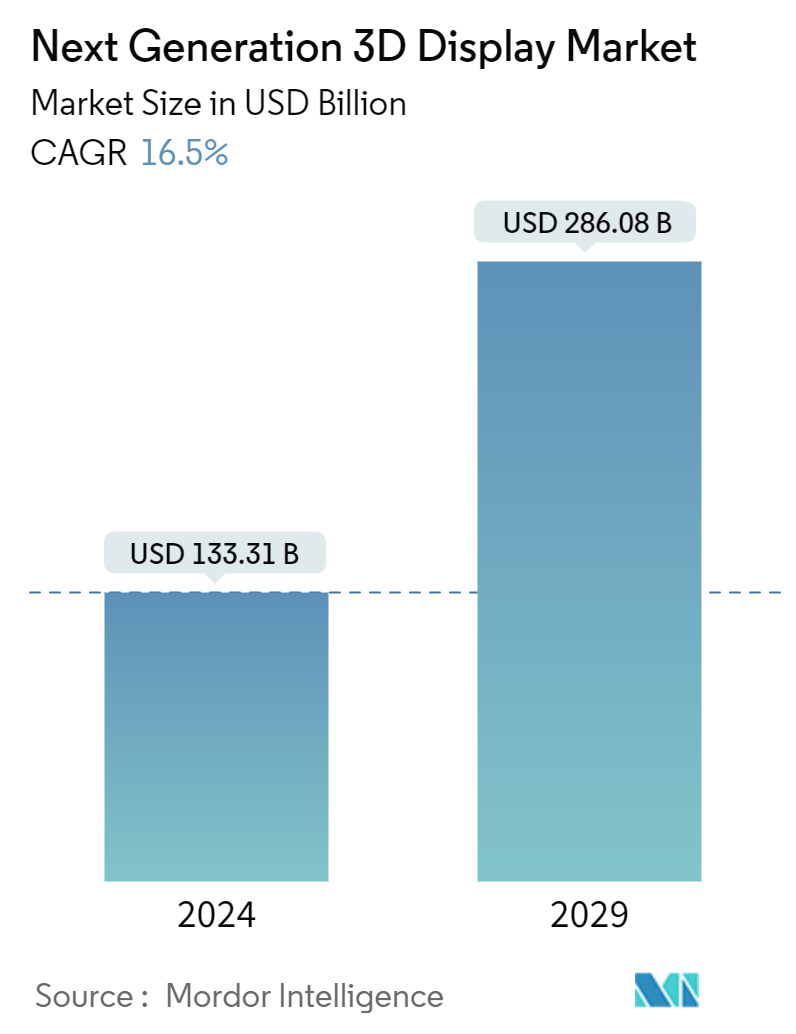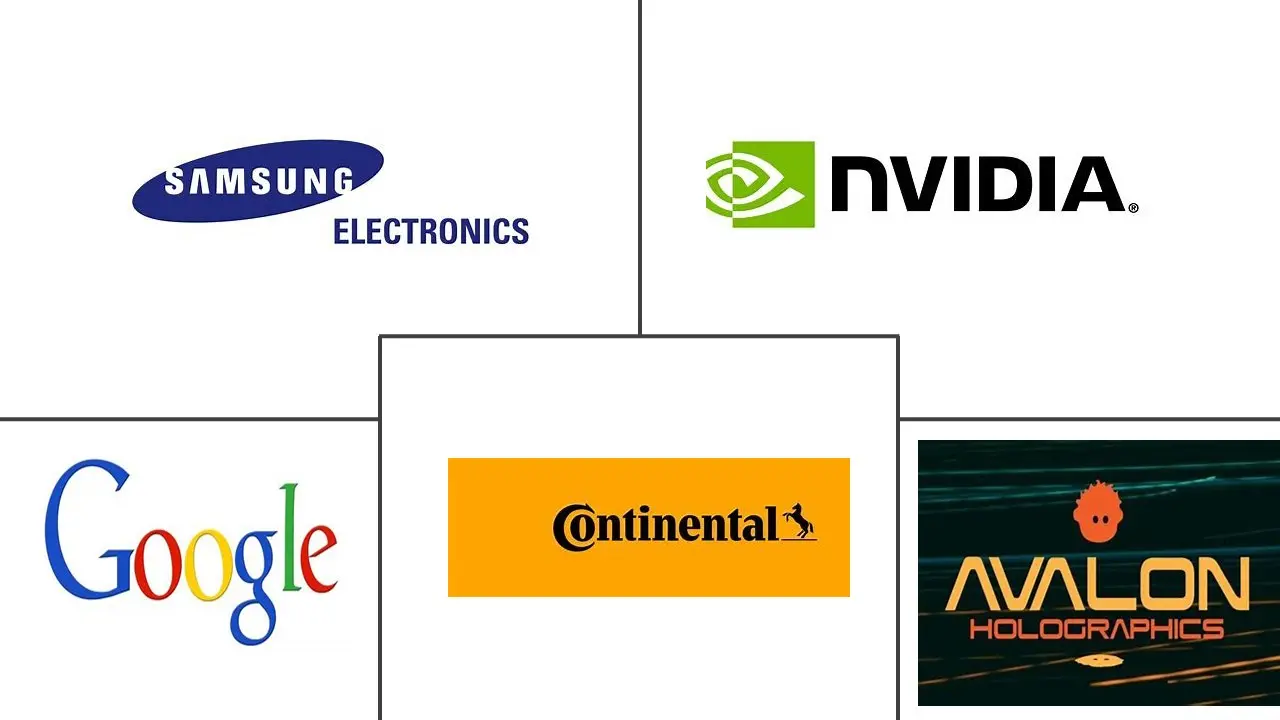Market Size of Next Generation 3D Display Industry

| Study Period | 2019 - 2029 |
| Market Size (2024) | USD 133.31 Billion |
| Market Size (2029) | USD 286.08 Billion |
| CAGR (2024 - 2029) | 16.50 % |
| Fastest Growing Market | Asia Pacific |
| Largest Market | North America |
| Market Concentration | Low |
Major Players
*Disclaimer: Major Players sorted in no particular order |
Next Generation 3D Display Market Analysis
The Next Generation 3D Display Market size is estimated at USD 133.31 billion in 2024, and is expected to reach USD 286.08 billion by 2029, growing at a CAGR of 16.5% during the forecast period (2024-2029).
The emphasis on developing multi-user displays and, in particular, using the refractive optics approach by the majority of companies, such as Samsung Electronics, Nvidia, Microsoft, etc., is also boosting the growth of the market.
- The continuous development in panel manufacturing, the introduction of 8K television, and the increasing emphasis on visual comfort are some of the factors driving the growth of the market. The increase in smart TV use throughout the globe drives market growth. According to Ofcom, in the last year, 67% of homes in the UK owned a Smart TV.
- For the purpose of gaining an competitive advantage on the market, some companies have already incorporated glassless 3D into their products. For instance, in March 2023, ZTE, a China-based tech company, announced introducing of its latest innovation, the Nubia pad 3D, which offers glass-free 3D visuals. This tablet features a 12.4-inch LCD screen with a native resolution of 2560x1600px with a 120Hz refresh rate and 16:10 aspect ratio. Furthermore, brands like Acer and Asus have already announced laptops with glass-less 3D technology.
- Moreover, the growth in the 5G deployment in industries as part of industrial automation also contributes to developing a connected ecosystem where 3D-displayed smartphones and computers play a vital role. According to HMS Networks, the industrial automation networking market grew by 6% in 2021, with wireless waiting for 5G in factories.
- PC gaming has become a favorite choice among millennial gaming enthusiasts. This shift is primarily due to multiple factors, such as the quality of gameplay, availability of high-end software and hardware, and improved internet bandwidth. Newer exciting, and demanding technology, such as VR and 3D displays, are available today. As a result, PC gamers are expected to upgrade their equipment accordingly, which is also one of the reasons for helping to drive the sales of gaming-specific PCs and accessories such as gaming screens.
- Moreover, the high cost of assembling 3D display devices is restraining the market growth. The procedure entails the production and construction of novel technologies, which could prove to be financially burdensome for smaller enterprises. Moreover, the pricing may appear expensive for consumers in less developed countries, constraining the expansion of the market.
Next Generation 3D Display Industry Segmentation
3D display provides three-dimensional visualization technology that can provide efficient tools to visualize and understand complex high-dimensional data and objects and a sense of depth to the viewer. It is an emerging technology increasingly adopted in various fields such as automotive, video, defense, and engineering simulation. 3D display is one of the new developments in the electronic industry as it offers a very immersive 3D viewing experience.
Next Generation 3D Display Market has been segmented by product (3D holographic display, head mounted displays (HMD), static volume displays), by technology (light emitting diode (LED), organic light emitting diode (OLED), plasma display panel (PDP)), access method (micro display, conventional/screen based display), by end-user industry (consumer electronics, automotive and transportation, medical), and by geography (North America, Europe, Asia Pacific, Latin America, Middle East and Africa). The market sizes and forecasts are provided in terms of value (USD) for all the above segments.
| By Product | |
| 3D Holographic Display | |
| Head Mounted Displays (HMD) | |
| Static Volume Displays | |
| Stereoscopy | |
| Swept Volume Displays | |
| Volumetric Displays |
| By Technology | |
| Digital Light Processing Rear-Projection Television (DLP RPTV) | |
| Light Emitting Diode (LED) | |
| Organic Light Emitting Diode (OLED) | |
| Plasma Display Panel (PDP) | |
| Liquid Crystal Display (LCD) |
| By Access Method | |
| Micro Display | |
| Conventional/Screen Based Display |
| By End User Industry | |
| Consumer Electronics | |
| Automotive and Transportation | |
| Medical | |
| Aerospace & Defense | |
| Industrial | |
| Others |
| By Geography | |
| North America | |
| Europe | |
| Asia | |
| Australia and New Zealand | |
| Latin America | |
| Middle East and Africa |
Next Generation 3D Display Market Size Summary
The next-generation 3D display market is poised for significant expansion, driven by advancements in technology and increasing consumer demand for immersive experiences. Companies like Samsung Electronics, Nvidia, and Microsoft are at the forefront, focusing on multi-user displays and refractive optics to enhance user engagement. The market is further bolstered by innovations such as glassless 3D technology, with brands like ZTE, Acer, and Asus leading the charge in integrating this feature into their products. The rise of smart TVs and the growing popularity of PC gaming, fueled by high-end software and hardware, also contribute to the market's growth. However, the high cost of assembling 3D display devices poses a challenge, particularly for smaller enterprises and consumers in less developed regions.
The consumer electronics segment is expected to experience robust growth, with increasing adoption of 3D displays in devices like monitors, TVs, smartphones, and laptops. The introduction of advanced features in smartphones and the expansion of VR and AR technologies present further opportunities for market expansion. Asia Pacific emerges as a lucrative market, with countries like Taiwan, China, and South Korea leading in consumer electronics advancements. The region's growth is supported by the easy availability of 3D gaming hardware and software, with major vendors like Nintendo contributing to its competitive edge. Despite the fragmented nature of the market, leading players are focusing on technological advancements and strategic partnerships to capture market share, ensuring continued growth and innovation in the 3D display industry.
Next Generation 3D Display Market Size - Table of Contents
-
1. MARKET INSIGHTS
-
1.1 Market Overview
-
1.2 Industry Value Chain Analysis
-
1.3 Industry Attractiveness - Porter's Five Forces Analysis
-
1.3.1 Bargaining Power of Suppliers
-
1.3.2 Bargaining Power of Consumers
-
1.3.3 Threat of New Entrants
-
1.3.4 Threat of Substitutes
-
1.3.5 Intensity of Competitive Rivalry
-
-
-
2. MARKET SEGMENTATION
-
2.1 By Product
-
2.1.1 3D Holographic Display
-
2.1.2 Head Mounted Displays (HMD)
-
2.1.3 Static Volume Displays
-
2.1.4 Stereoscopy
-
2.1.5 Swept Volume Displays
-
2.1.6 Volumetric Displays
-
-
2.2 By Technology
-
2.2.1 Digital Light Processing Rear-Projection Television (DLP RPTV)
-
2.2.2 Light Emitting Diode (LED)
-
2.2.3 Organic Light Emitting Diode (OLED)
-
2.2.4 Plasma Display Panel (PDP)
-
2.2.5 Liquid Crystal Display (LCD)
-
-
2.3 By Access Method
-
2.3.1 Micro Display
-
2.3.2 Conventional/Screen Based Display
-
-
2.4 By End User Industry
-
2.4.1 Consumer Electronics
-
2.4.2 Automotive and Transportation
-
2.4.3 Medical
-
2.4.4 Aerospace & Defense
-
2.4.5 Industrial
-
2.4.6 Others
-
-
2.5 By Geography
-
2.5.1 North America
-
2.5.2 Europe
-
2.5.3 Asia
-
2.5.4 Australia and New Zealand
-
2.5.5 Latin America
-
2.5.6 Middle East and Africa
-
-
Next Generation 3D Display Market Size FAQs
How big is the Next Generation 3D Display Market?
The Next Generation 3D Display Market size is expected to reach USD 133.31 billion in 2024 and grow at a CAGR of 16.5% to reach USD 286.08 billion by 2029.
What is the current Next Generation 3D Display Market size?
In 2024, the Next Generation 3D Display Market size is expected to reach USD 133.31 billion.

